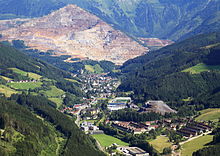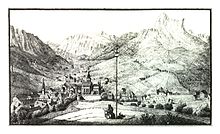Iron ore (Styria)
|
Borough Iron ore
|
||
|---|---|---|
| coat of arms | Austria map | |
|
|
||
| Basic data | ||
| Country: | Austria | |
| State : | Styria | |
| Political District : | Leoben | |
| License plate : | LN | |
| Surface: | 124.46 km² | |
| Coordinates : | 47 ° 33 ' N , 14 ° 53' E | |
| Height : | 736 m above sea level A. | |
| Residents : | 3,806 (January 1, 2020) | |
| Postal code : | 8790 | |
| Area code : | 03848 | |
| Community code : | 6 11 01 | |
| NUTS region | AT223 | |
| Address of the municipal administration: |
Mario-Stecher-Platz 1 8790 Eisenerz |
|
| Website: | ||
| politics | ||
| mayor | Thomas Rauninger ( ÖVP ) | |
|
Municipal Council : ( 2020 ) (21 members) |
||
| Location of Eisenerz in the Leoben district | ||
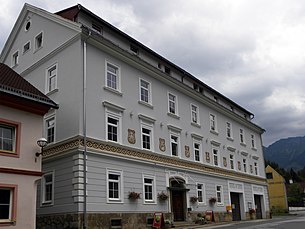 town hall |
||
| Source: Municipal data from Statistics Austria | ||
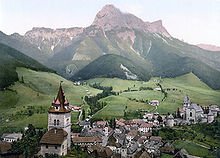
Eisenerz is a city with 3,806 inhabitants (as of January 1, 2020) in the north of Styria , around 25 km northwest of the district capital Leoben .
The former name of the community in the judicial district or district of Leoben was Innerberg .
geography
Eisenerz is located on the Erzbach in the midst of the towering cliffs of the Eisenerzer Alps in the southwest and the Hochschwab in the northeast. The four rock formations of Eisenerzer Reichenstein , Wildfeld , Kaiserschild and Pfaffenstein dominate the cityscape. Then there are the reddish colored steps of the Erzberg , which is the largest iron ore open-cast mine in Central Europe.
In the north of the municipality lies the Leopoldsteiner See .
Community structure
The municipality of Eisenerz consists of the cadastral municipalities of Eisenerz, Krumpental, Münichthal and Trofeng.
The only village is the city of Eisenerz. Districts are Krumpental, Münichtal and Trofeng. Eisenerz is also divided into numerous districts, the most important of which are Blumau, Galleiten, Geyeregg, Großfölz, Gsoll, Münzboden, Paigler, Prossen, Schlingerweg, Seeau and Seestrasse.
Neighboring communities
| Hieflau (until 2014 municipality; from 2015 part of Landl) | Rural | Wild Alps |
| Radmer |

|
Tragedy |
| Kalwang | Trofaiach | Vordernberg |
history
In 1230 the area was mentioned for the first time in a document under the name Aerze , then in 1293 in the inner iron doctor . In 1453 the granting of market rights is documented. The mining rights on the Erzberg belonged to the Eisenerzer and Vordernberg wheel masters from the Middle Ages . Ore mining flourished on the Erzberg until the end of the 16th century . Around 1500 iron ore accounted for 16 percent of the European export volume; around 1550 it was around 20 percent.
In 1529, when the Turks besieged Vienna , the fortifications of the Oswaldi Church were reinforced. From 1519 onwards, Protestantism spread in Styria and developed into a majority religion in Eisenerz by the middle of the 16th century. In the peasant uprising in 1525, which was mixed with misunderstood Lutheran religious demands, the miners, wind house workers and the citizenry from iron ore also took part. Records from the Brucker Winkellandtag in 1572 show that Eisenerz, along with 14 other cities and markets, publicly declared that it was part of the Augsburg Confession. Numerous buildings in Eisenerz bear witness to the heyday of wheel mastership at this time, such as the shift tower and the Schwarzer Hof .
As part of the Counter-Reformation , the Protestant part entrenched the citizens and Radmeister 1599 in the church fortress from Johann Hoffmann , the abbot of Admont , who at the behest of sovereign Ferdinand II. With his accompanying mercenaries, as well as 316 additional players selected shooters and halberdiers forced to give up . Government measures such as confiscations, the compulsion to sell the wheel works to Catholic buyers and the expulsion of those who remained loyal to the Augsburg Confession , the burning of sectarian books or 50 of the population “soldiers put in their quarters” were able to convert the vast majority back to Catholicism . At least 14 cycling champions and their families were on the final expulsion list.
The expulsion and replacement of some of the bike masters who had been mixed up with one another by non-residents and the beginning of the Thirty Years' War plunged the bike masters into financial problems. In 1625, the sovereign took over mining in the Innerberger part of the Erzberg, including processing and trading. The wheel works and mining rights were compulsorily incorporated and the Innerberger main trade union was founded, which administered the Eisenerzer part of the ore mountain until 1881. The mining rights of the Vordernberger Radmeister were used by them until the end of the 19th century. The main trade union in Innerberg also included the hammer mills in Ennstal and the iron dealers of the city of Steyr . In the 17th century, the Innerberger main union developed into the largest iron producing company in the world.
Even women and children were employed in mining. From 1750, attempts were made several times and by various higher authorities, most recently by court decree from Vienna on February 15, 1772, to introduce the spinning trade for women and children in Eisenerz. But all these attempts failed, and a patent issued in 1765 on the introduction of spinning schools did nothing. In 1768, the cycling community rejected an order from the court in Vienna on the grounds that women and children were needed for miner work and that there was a lack of housing due to the introduction of free marriage permits . The new request in 1772 was answered by the cycling community with a reference to this report and the remark that "the realization of the highest request is impractical from every side", and the Upper Chamber of Commerce responded negatively. By court decree of September 4th of the same year, the introduction of spinning in iron ore was finally abandoned.
In 1881 the Oesterreichisch-Alpine Montangesellschaft was founded, which gradually acquired the mining rights for the entire Erzberg and began mining the floors on the Erzberg, which has given the mountain its characteristic shape today. During this time, the cog railway known as the Erzbergbahn was built across the Präbichl to Vordernberg and Leoben .
In 1931/32 the mining operation was practically on the verge of ruin. During the time of National Socialism , iron ore experienced a renewed boom due to the raw materials and armaments industry. With 1.8 million tons, almost a quarter of the production in the German Empire came from the Erzberg. In December 1939 the first 300 Polish forced laborers arrived at the Erzberg, followed by thousands of forced laborers from different countries as well as prisoners of war and concentration camp inmates from Mauthausen.
In 1946, twelve men were sentenced to death by British military courts in the iron ore trials . As Volkssturm people or superiors, you carried out or ordered a massacre of around 250 Hungarian Jews on April 7, 1945 on the Präbichl , who were on a death march towards Mauthausen concentration camp . The trials are among the most important war crimes trials in Austria.
Due to the flourishing mining industry and the numerical size (13,000 inhabitants) of the community, it was granted town charter in 1948. Due to technical innovations in the mining sector itself, but also due to the global crisis in the iron and steel industry in the 1980s, the population shrank to a third over the course of a strong half century.
legend
The forecast by the natives of Erzbachtals owe the discovery of the Erzberg an Aquarius out of the water manhole at the end of the valley of Münichtals . The Aquarius was captured by the villagers with a coat coated with pitch, and for his release he offered them the following:
Gold for ten years,
silver for a hundred years,
or iron for ever!
The clever residents opted for iron.
Religions
- Roman Catholic 66.9%
- Evangelical 4.2%
- Islamic 1.5%
- Without rel. Confession 24.6%
- Others 2.8%
Population development

Eisenerz is the oldest city in Austria, with 40% of the population over 65 years of age.
coat of arms
The municipal coat of arms was awarded with effect from August 1, 1948.
Blazon (coat of arms description):
- “In a golden, blue bordered shield, the stylized contours of the Styrian ore mountain with its steps can be seen in its current form in the form of red lines. In the shield on the stone ground stands the figure of a young man in the white costume with the hood of a miner and black shoes, who is holding a red label with both hands crossed by a silver bar and covered with a miner's scraper and a recovery iron next to each other on stakes. "
Community partnerships
- since ? Steyr , Upper Austria

Culture and sights
- City Museum in the Old Town Hall, Bergmannsplatz 1.
- Post Museum in the Kammerhof, the former headquarters of the Innerberg main trade union .
- Nativity Museum , with nativity scenes from the late 19th century to the present day.
- Tannery Museum Tannery Salzer .
- Parish Church of St. Oswald : The Gothic church, dedicated to Oswald of Northumbria , from the 15th to 16th centuries. Century is the largest fortified church in Styria (fortifications from 1532 to 1534).
- Erzbergbahn : Museum railway that runs from Vordernberg over the Präbichl to the Erzberg station.
- Schwarzer Hof is one of the last, almost originally preserved, medieval wheel master houses in Styria.
- Leopoldstein Palace : Between 1666 and 1670, Baron Leopold von Neidthardt zu Spathenbrunn had the so-called “Saurießlgut” converted into a palace and named it “Leopoldstein Palace” in honor of Emperor Leopold . Most of it burned down in 1706 under the owner Johann G. Ledermayer. After the property came into the possession of Prince Arnulf of Bavaria around 1880 , he had it rebuilt in the historicizing style between 1890 and 1895 based on the example of the Bavarian royal castles.
- Currently (2015) it is used as the youth sports center of the State of Styria.
- Market Church of the Birth of Mary from 1453, later redesigned in Baroque style.
- Petruskapelle
- The layer tower in the Renaissance style heralds the miners to the film since the 1581st
- Geyeregg Castle from 1621/22
- “Zainhammerl” blacksmith's and inflatable house : The almost demolished property at Krumpentalerstraße 13 turned out to be the last blacksmith's shop in the city, the interior of which is still preserved. It is probably also the last Zainschmiede in Styria.
Iron ore is surrounded by mountains, here the Pfaffenstein
For a long time, the Erzberg industry was the most important employer
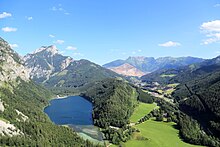

- The Wassermannsloch is a karst spring north of the village. Its cave system was measured at more than 1000 m. The deep spring basin is probably connected to Lake Leopoldstein . The Wassermannloch is the central location of the Aquarius legend , which is about finding the Erzberg .
- Frauenmauerhöhle : stalactite cave with an ice chamber and stone formations worth seeing (644 m long)
- Leopoldsteiner See : Mountain lake with excellent water quality, 1 km long, 500 m wide, the deepest point approx. 31 m
Regular events
- Summer festival: annual festival in July, with music, visual arts and sound visions at Lake Leopoldstein
- ErzbergRodeo : since 1995, every weekend after Corpus Christi (May / June), Mortorradrennen, the largest enduro event in Europe
- Erzberglauf : The Erzberglauf , which has taken place annually since 2003, is a running and Nordic Walk competition in which 745 meters of altitude are overcome over a distance of 12.5 km. The Erzberglauf is an international competition that attracts an average of more than 1000 athletes every year.
- Anna Kirtag: Since 1981, in the Eisenerzer Ramsau by nature lovers of Anna Kirtag organized. In contrast to Oswaldikirtag, there are hardly any stalls on Annakirtag, the focus is on folk music, dance and local culinary specialties.
- eisenerZ * ART : Since 2010, the city has been artistically used as part of the art and culture project eisenerZ * ART at different times throughout the year. The various artistic and cultural offers include art exhibitions, installations, performances and other art events, art competitions, theater and amateur film productions as well as artist and book presentations.
- Rustproof : Since 2012, the rustfest has been taking place in August with music, video projection on house facades, art, adventure, " urban camping " in empty buildings. The festival paused in 2017, the organizers are currently revising the organizational structure and the programmatic direction.
Economy and Infrastructure
In the recent past Eisenerz has tried to distinguish itself as a tourist community. Attractions for this are on the one hand the Erzberg , where a show mine has been set up in the tunnels, and on the other hand the natural conditions of the Eisenerzer Alps and the Hochschwab , which are intended to attract hikers and mountaineers.
Eisenerz is the historical center of the Austrian Iron Road . The places on the old Eisenstrasse, which are located in the Austrian federal states of Styria, Upper Austria and Lower Austria, have joined together to form regional Eisenstrasse associations, whose task it is to make the area known as a cultural and tourist region worth visiting.
Via ferratas : Between 2005 and 2007, four new, challenging via ferratas were built in the mountains around Eisenerz, which place high demands on mountaineering skills.
- The Eisenerzer Steig leads to the Pfaffenstein (1865 m), difficulty level C / D (difficult to very difficult);
- The Kaiserschild via ferrata leads to the Kaiserschild (2084 m), difficulty level D / E (difficult to extremely difficult);
- The Kaiser-Franz-Joseph-Klettersteig through the lake wall behind the Leopoldsteiner See has difficulty level D (very difficult);
- The Rosslochhöhlen via ferrata in the Seemauer has difficulty level D / E (difficult to extremely difficult).
In addition, in the high valley of the Eisenerzer Ramsau , which is characterized by abundance of snow and cold, there is a Nordic skiing center with four ski jumps ( Erzbergschanzen ), a natural toboggan run and a biathlon facility.
Eisenerz has accommodation establishments and private room rental companies, but to this day no hotel.
The structural change towards the tourist community is taking place only slowly, so in some cases larger projects have been planned for years and then rejected due to lack of demand. B. the “Rogner Project”, a medium-sized ski area in the Eisenerzer Ramsau, or the “Seehotel” on the Leopoldsteiner See.
Companies
- VA-Erzberg: Mining on the Erzberg
- SBB Eisenerz (formerly BTE)
- CCI modular construction
- Napalm Records Handels GmbH
- MAXAM Austria GmbH
- Primaras Handels GmbH
- J. Radlingmaier Transport and Construction GmbH
- PLUS trading company
- ZPP Dentalmedizintechnik GmbH
- BK-DAT Electronics eU
traffic
- Public transport: Eisenerz is located on the Erzbergbahn . The connection to the south, via the Präbichl to Leoben , was discontinued in 1988, and the Hieflau –Eisenerz railway line coming from the north is now only served by freight trains. Eisenerz can therefore only be reached by public transport by road. There are regular connections to Leoben and Hieflau with Postbuses .
- Individual traffic: Eisenerz is located on Eisen Straße B 115, which leads from Leoben via Eisenerz to Steyr and Enns in Upper Austria . The next high-ranking roads are the Semmering expressway S 6 and the Pyhrn motorway A 9 near Leoben.
- Cycle paths: The Eisenstrasse between Hieflau and Leoben via Eisenerz and the Präbichl, as a connection between the Enns and Murtal cycle paths, is an alternative to the journey through Gesäuse via Admont and Selzthal to St. Michael and Leoben. The cycle path ends after the village of Eisenerz, via the Pass must be used the road.
education
- Bundesoberstufenrealgymnasium Eisenerz (sports and creative branch)
- Federal Trade Academy Eisenerz (information technology, tourism and technology branch)
- Neue Mittelschule Eisenerz (sports branch, ski branch and general)
- Nordic Training Center (NAZ)
- JEB (Vocational Apprenticeship Training)
- Polytechnic School (POLY)
- Center on the mountain , experimental tunnel of the Montan University Leoben and training center for disaster control
Sports
- Erzbergrodeo : The ErzbergRodeo is an enduro motorcycle race that has been held annually in May or June since 1995 on the Erzberg near Eisenerz, the largest of its kind in Europe. The " ErzbergRodeo " motorsport event has been an internationally recognized major sporting event for some time. The number of participants is up to about 1500 and is considered one of the most difficult off-road races in the world.
- In Eisenerz there is a base of the Austrian Ski Association for Nordic sports such as cross-country skiing , ski jumping and Nordic combined - the Nordic Training Center Eisenerz (NAZ Eisenerz). There are three ski jumps ( Erzbergschanzen ), a natural toboggan run and a newly built biathlon facility.
- Via ferratas : From 2005 to 2007, four new, challenging via ferratas were built in the mountains around Eisenerz, which place high demands on mountaineering skills. (see 'Tourism and Economy')
- Sport shooting: Sport shooting at SV Eisenerz is another sporting activity that can be carried out in Eisenerz. This has a small hall for the air pistol and air rifle disciplines directly on Hieflauerstraße. In the Tull there is also a shooting range for hunters, small-caliber and large-caliber disciplines. Several competitions are held here every year, such as cups and state championships.
- Nordic skiing center with ski jumps : In addition, in the high valley of the Eisenerzer Ramsau , which is characterized by abundance of snow and cold, there is a Nordic skiing center with three ski jumps ( Erzbergschanzen ), a natural toboggan run and a newly built biathlon facility .
politics
The municipal council has 21 members.
- With the municipal elections in Styria in 2000, the municipal council had the following distribution: 14 SPÖ, 4 ÖVP, 3 Greens, 2 KPÖ and 2 FPÖ. (25 members)
- With the municipal elections in Styria in 2005 , the municipal council had the following distribution: 17 SPÖ, 3 ÖVP, 2 KPÖ, 2 Greens and 1 FPÖ.
- With the municipal council elections in Styria 2010 , the municipal council had the following distribution: 16 SPÖ, 5 ÖVP, 3 KPÖ and 1 FPÖ. (25 members)
- With the municipal council elections in Styria in 2015 , the municipal council had the following distribution: 12 SPÖ, 4 KPÖ, 3 ÖVP and 2 FPÖ. (21 members)
- With the municipal council elections in Styria 2020 , the municipal council has the following distribution: 9 ÖVP, 7 SPÖ, 3 KPÖ and 2 FPÖ. For the first time since 1945, the ÖVP became the party with the highest number of votes.
mayor
- until 2009 Gerhard Freiinger (SPÖ)
- since 2009 Christine Holzweber (SPÖ)
Personalities
Honorary citizen of the community
- 1988 Hans Gross (1930–1992), Deputy Governor
Sons and daughters of the church
- Jacob Joseph Winterl (1732–1809), physician, botanist, pharmacist and chemist
- Johann Max Tendler (1811–1870), painter
- Franz Schneeweiss (1831–1888), Austrian-American theologian, organist, choir director and composer
- Viktor Apfelbeck (1859–1934), Austrian-Yugoslav entomologist and museum curator
- Alois Brandl (1864–1926), politician
- August Musger (1868–1929), inventor of slow motion
- Agnes Millonig (1884–1962), local poet
- Stefanie Psonder (1911–1966), politician
- Franz Zehrer (1911–1992), church musician, organ expert and theologian
- Matthias Krempl (1917–1997), politician (ÖVP) and industrial employee
- Stefan Kölly (1928–2018), soccer player and coach
- Erich Kitzmüller (* 1931), social scientist and business philosopher
- Gerhard Niederhammer (* 1940), skier
- Ernst Längauer (1941–2007), politician (SPÖ) and security engineer
- Karl Pietsch (* 1943), politician (SPÖ)
- Reinhold Bachler (* 1944), ski jumper
- Leo Pröstler (* 1947), entrepreneur and environmentalist
- Stephan Eibel Erzberg (* 1953), writer
- Christine Brunnsteiner (* 1954), moderator and author
- Christa Kern (* 1958), actress, author, chansonette and speaker
- Harald Munichthal (* 1966), graphic artist, painter and copywriter
- Helga Ahrer (* 1967), politician (SPÖ)
- Oliver Strohmaier (* 1968), ski jumper
- Mario Stecher (* 1977), Nordic combined athlete
- Andreas Schranz (* 1979), soccer player
- Daniela Iraschko (* 1983), ski jumper and soccer goalkeeper
- Lukas Klapfer (* 1985), Nordic combined athlete
People related to the community
- Ferdinand Marian (1859–1942), singer
- Thomas Schächl (* 1966), actor and teacher
- Joachim Standfest (* 1980), soccer player
- David Zauner (* 1985), ski jumper
literature
- Daniel Blatman: The Death Marches 1944/45. The last chapter of the National Socialist mass murder. From the Hebrew v. Markus Lemke . Rowohlt, Reinbek 2011, ISBN 3-498-02127-3 .
- Stadtgemeinde Eisenerz (Ed.): Eisenerz. A local history reader. Iron ore 2008.
Individual evidence
- ^ A b Roman Sandgruber: The state made of steel. diepresse.com, accessed January 9, 2013 .
- ↑ Rudolf Leeb, Susanne Claudine Pils, Thomas Winkelbauer: State power and salvation of the soul: Counter-Reformation and secret Protestantism in the Habsburg monarchy . 2007, p. 319 ( full text ).
- ↑ Fritz Bayerl u. a .: Around the Hochschwab. Iron ore. In: Austria-Lexikon. Hermann Maurer , accessed December 8, 2012 .
- ↑ Maja Loehr: The bike masters on the Styrian Erzberg until 1625 . Sociological investigation. Ulrich Moser Verlag Graz-Vienna, July 15, 1941, p. 28–30 ( PDF [accessed November 1, 2012]).
- ↑ Gerhard Pferschy: Attempts to introduce wage spinning work among the women and children of the ore miners . ( steiermark.at [PDF; accessed on November 1, 2012]).
- ↑ Nazi forced labor on the Erzberg (Styria) .
- ^ Daniel Blatman: The Death Marches 1944/45. P. 357
- ↑ Communications from the Styrian State Archives 12, 1962, p. 25
- ↑ Schloss Leopoldstein ( Memento of the original from August 21, 2014 in the Internet Archive ) Info: The archive link has been inserted automatically and has not yet been checked. Please check the original and archive link according to the instructions and then remove this notice. , Eisenstrasse.co.at, accessed on July 11, 2015
- ↑ Eisenerz smithy and blow house. (No longer available online.) Association for the Research and Preservation of Austrian Building Culture, archived from the original on September 23, 2015 ; Retrieved December 17, 2012 . Info: The archive link was inserted automatically and has not yet been checked. Please check the original and archive link according to the instructions and then remove this notice.
- ↑ Results of the 2005 municipal council elections in Eisenerz. State of Styria, March 13, 2005, accessed on July 28, 2020 .
- ^ Election result of the municipal council election 2010 in Eisenerz. State of Styria, March 21, 2010, accessed on July 28, 2020 .
- ^ Election results for the 2015 municipal council elections in Eisenerz. State of Styria, March 22, 2015, accessed on July 28, 2020 .
- ↑ Results of the municipal council election 2020 in Eisenerz. State of Styria, June 28, 2020, accessed on July 28, 2020 .
Web links
- 61101 - Eisenerz (Styria). Community data, Statistics Austria .
- Website of the Eisenerz community




